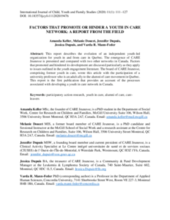Displaying 781 - 790 of 2502
The purpose of this study was to describe the demographics, state-dependent living situations, and juvenile detention usage of state-dependent commercially sexually exploited youth.
Using a sequential, mixed methods approach, data from 115 sexually active African American youth in foster care (17-20 years old) were analyzed to determine their level of protection and whether gender was a factor in their prevention efforts.
In this opinion piece for Youth Today, Benjamin Bencomo - an assistant professor of social work at New Mexico Highlands University - writes about his experience as a social worker supporting an Indigenous young person as he aged out of foster care and how he learned to allow the young person to define his own goals for a successful transition to adulthood.
The purpose of this paper is to examine child characteristics and child welfare services associated with high welfare costs in the US, defined as the top decile of child welfare costs.
This report describes the evolution of an independent youth-led organization for youth in and from care in Quebec, Canada
This article from the Marshall Project describes how thousands of U.S. children are removed from their homes each year to be placed in foster care for only a few days and later returned to their families.
The premise of this paper is that Indigenous peoples are multiplicatively oppressed and that these intersecting sites of oppression increase the risk of Indigenous peoples in Canada becoming homeless. The study found that Indigenous identity, involvement in the child welfare system, and level of educational achievement were all significantly associated with experiences of hidden and visible homelessness.
The premise of this paper is that Indigenous peoples are multiplicatively oppressed and that these intersecting sites of oppression increase the risk of Indigenous peoples in Canada becoming homelessness. Hypotheses were tested using the 2014 panel of Canada’s General Social Survey, including 1081 Indigenous peoples and 23,052 non-Indigenous white participants.
This research explains how and why homelessness occurs among youth with serious mental health struggles after aging out of residential and transitional living programmes.
This second of a two-part paper discusses stage two of a two-stage, transatlantic study aimed at identifying and exploring threshold concepts in residential child care.

